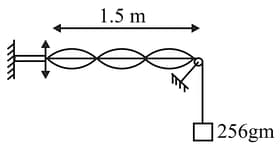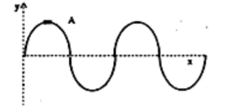Formation of Stationary Waves on String
Formation of Stationary Waves on String: Overview
This topic covers concepts, such as, Equation of Standing Waves,Normal Modes of Oscillation for a Stretched String Fixed at Both Ends,Condition for Formation of Antinodes etc.
Important Questions on Formation of Stationary Waves on String
In a sonometer wire the tension is maintained by suspending a 50.7 kg mass from the free end of the wire. The suspended mass has volume of 0.0075m3. The fundamental frequency of the wire is 260Hz. Find the new fundamental frequency if the suspended mass is completely submerged in water
The fundamental frequencies of two copper wire of same length are in the ratio . If the tension on the wires are and respectively, then the ratio of their diameters will be:
A string of length and mass is under tension . When the string vibrates, two successive harmonics are found to occur at frequencies and . The value of tension is _____ newton.
A wire of density is stretched between two clamps apart. The extension developed in the wire is . If , the fundamental frequency of vibration in the wire will be _____
A guitar string of length vibrates with a fundamental frequency of . The length of the string producing a fundamental of will be _____
In an experiment with sonometer when a mass of is attached to the string, it vibrates with fundamental frequency of . When a mass is attached, the string vibrates with fundamental frequency of . The value of is ______ .
The fundamental frequency of vibration of a string between two rigid support is . The mass of the string is and its linear mass density is . The speed of the transverse waves so produced in the string is _______ .
A standing wave is maintained in a taut string where and are expressed in meters. The distance between the successive points oscillating with the amplitude across a node is equal to
A string fixed at both ends produces successive resonance frequency and . Wave speed in string is . Find the value of.
When a tuning fork vibrates with or long wire (both in same mode), beats per second are produced in each case. If the frequency of the tuning fork is (in ) find.
A string fixed at both ends produces successive resonance frequency and . Wave speed in string is , then is
Equation of a stationary wave can be expressed as hereand are in cm and in second, wavelength of any component of progressive wave is
Write down an expression for the fundamental frequency of transverse vibration of a stretched string. If the vibrating wire is touched lightly at a point rd distance from one end, what will happen?
A string vibrates with a frequency of . Another frequency with which the string can vibrate is . The number of harmonic of the first frequency is
A steel wire in diameter is fixed to a support at one end and is wrapped round a cylindrical tuning peg in diameter at the other end. The length of the wire between the peg and the support is . The wire is initially kept taut but without any tension. If the fundamental frequency of vibration of the wire if it is tightened by giving the peg a quarter of a turn is . Then find the value of
Density of steel of steel .
A string is stretched between a pulley and a wave generator consisting of a plate vibrating up and down with small amplitude and frequency . The standing wave pattern has nodes as shown. What should be the load (in gm) we want a standing wave with nodes.

A string will break apart if it is placed under too much tensile stress. One type of steel has density. and breaking stress . We make a guitar string from gram of this type of steel. It should be able to withstand without breaking. What is highest possible fundamental frequency (in ) of standing waves on the string if the entire length of the string vibrates?
Choose correct statements

The distance between two successive nodes is .
A spring, fixed at one end, is connected to a steel wire of length . The other end of the steel wire is connected to an AC source providing a sinusoidal signal of fixed frequency . This stretches the spring and produces standing waves. The spring stretched by produces a standing wave with four antinodes in the steel wire. The stretch of the spring which will produce a standing wave of three antinodes is
